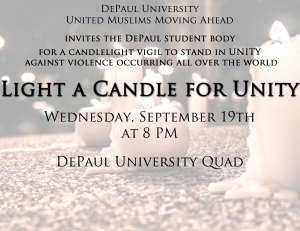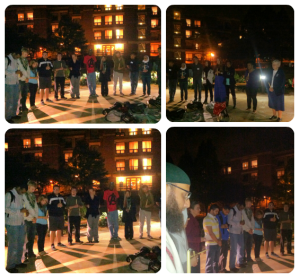 As winds blew through the Chicago skyline on Wednesday the 18th of September, a group of student leaders from the United Muslims Moving Ahead DePaul University on-campus organization decided to hold a candle-light vigil. The vigil was a call for students and faculty to stand together in unity against violence occurring all over the world. During the Unity Vigil the students gave their respects to the United States Ambassador Christopher Stevens who was serving in the US embassy in Libya. We came together on an evening to condemn the violent protests that erupted as a result of the movie “Innocence of Muslims” which meant to insult the Prophet Mohammed (Peace and Blessings Be Upon Him). We also stood together against violence happening within the Syrian Crisis, the daily shootings in Chicago’s neighborhoods, and anywhere else across the world.
As winds blew through the Chicago skyline on Wednesday the 18th of September, a group of student leaders from the United Muslims Moving Ahead DePaul University on-campus organization decided to hold a candle-light vigil. The vigil was a call for students and faculty to stand together in unity against violence occurring all over the world. During the Unity Vigil the students gave their respects to the United States Ambassador Christopher Stevens who was serving in the US embassy in Libya. We came together on an evening to condemn the violent protests that erupted as a result of the movie “Innocence of Muslims” which meant to insult the Prophet Mohammed (Peace and Blessings Be Upon Him). We also stood together against violence happening within the Syrian Crisis, the daily shootings in Chicago’s neighborhoods, and anywhere else across the world.
As an Interfaith Scholar, there was nothing more meaningful that night than to be supported by faculty members and students representing diverse faith and spiritual backgrounds standing shoulder-to-shoulder in unity against violence. The importance and significance for us all to experience and share each other’s feelings about certain on-goings around the world is something that this world needs more of. But to then take it a step further by building a support system, and embracing one another in a time that calls us to do so, is hopefully an eternal bond that each one of us can use.
The Muslim Chaplain at DePaul Abdul-Malik Ryan, reached out to the DePaul community through an email inviting his colleagues and students to attend the vigil, “In light of the continued violence here in Chicago and around the world, and especially the violence that is being presented as a motivation of ‘religious faith,’ the students want to make a strong statement that the DePaul community, and especially people of all faiths here at DePaul stand united against violence and as witnesses for peace and justice.” Chaplain Abdul-Malik stressed the fact that Islam as a religion condemns violence and prohibits the killing of innocent people.
Another member that is dear to the DePaul community and a representative from the University Ministry Office and Assistant Chaplain of the Office of Religious Diversity, Katie Brick shared a piece from the Superior General Gregory Gay, who wrote about Vincentian non-violence. Chaplain Brick read out a few quotes in which General Gray characterized non-violence as though it should be used as a means of “creating harmony based on diversity, rather than using diversity as a justification for violence.” This phrase stood out to me personally because it embraced the theme of unity – the purpose and reason to why we were all standing together.
On September 25th, President Barack Obama spoke to the United Nations General Assembly stating, “We have taken these positions because we believe that freedom and self-determination are not unique to one culture. These are not simply American values or Western values – they are universal values.” Standing together as a strong and diverse DePaul community acknowledging the pain and creating a safe space that creates the chance for all of us to embrace one another, and to share our experiences with one another.
Our shared presence at the Unity Vigil affirmed to me and to the rest of the DePaul Community that brotherhood and sisterhood exists in a diverse form on campus. The Unity Vigil was also a way for the DePaul community to spread awareness about the violence going on in the world. And as I write this blog post I can’t help but sing the words of the song written by India Arie, “There’s hope, it doesn’t cost a thing to smile, you don’t have to pay to laugh, you better thank God for that.”
Dana Jabri ’15
